If you want to capture the look of a classic cottage garden, one type of perennial flower to plant is lupines.
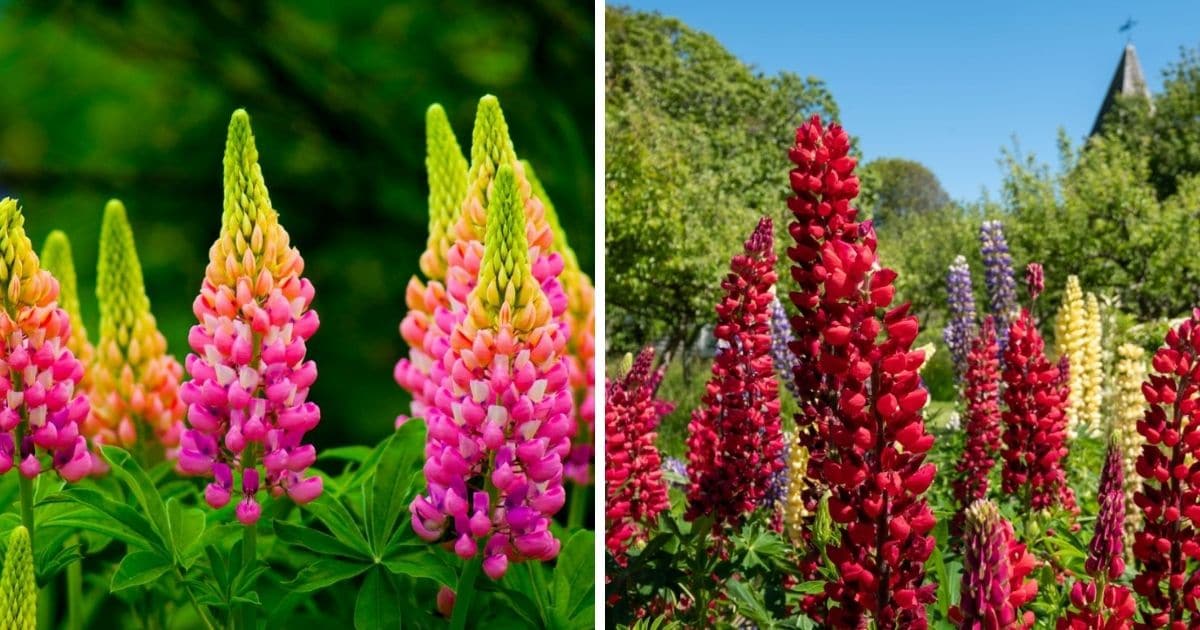
This guide will teach you how to plant lupines and care for them, as well as information about when they bloom, landscaping ideas, and more. You can jump to the topic you are looking for in the table of contents below, or read the full guide by scrolling down.
Jump to:
- What Are Lupines?
- Lupine Basics
- Where Do Lupines Grow?
- Why Grow Lupines?
- Lupine Landscaping Ideas
- Recommended Lupine Varieties
- When Do Lupines Bloom?
- How Long Do Lupines Bloom?
- When to Plant Lupines
- Ideal Growing Conditions for Lupines
- How to Plant Lupines
- How to Care for Lupines
- How to Divide and Transplant Lupines
- Recommended Companion Plants for Lupines
- Frequently Asked Questions About Growing Lupines
- Where to Buy Lupines
What Are Lupines?
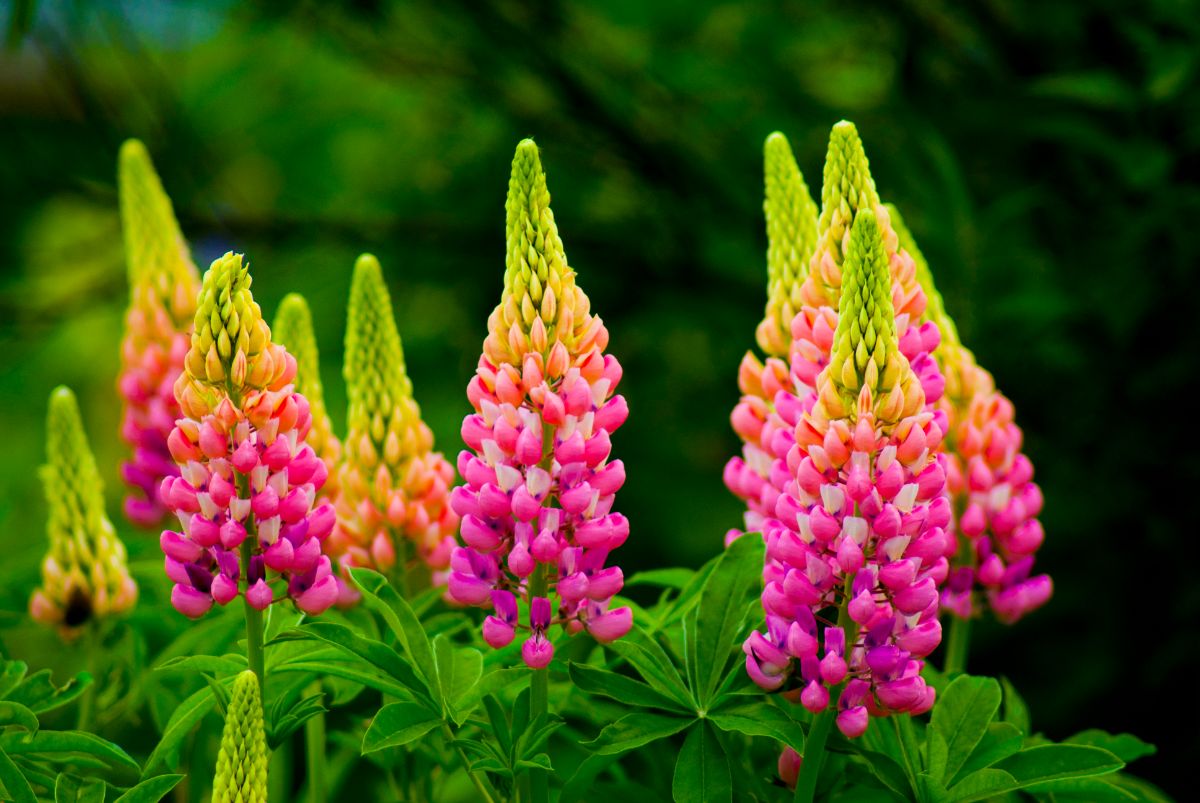
Lupines are members of a genus of plants called Lupinus, which is part of the family Fabaceae. There are more than 199 species in the genus. Sometimes, lupines also are called “lupin” plants. In some areas, they are called “bluebonnets” as well.
When you grow lupines, you can look forward to tall stalks of colorful blossoms gracing your yard.
While both perennial and annual varieties of lupines exist, the ones that are sold as nursery plants are almost always perennials. That means that they come back every year.
If you are buying lupine seeds, you will need to pay closer attention, as there is a higher chance of encountering an annual variety for sale.
The Fabaceae family is actually the legume family. In fact, lupine plants produce beans. Lupine beans are not particularly popular in the US. But if you visit Europe, the Middle East, or North Africa, you might find dishes that include lupine beans as ingredients.
Indeed, the history of lupine beans in food dates back centuries. They were actually cultivated quite widely by ancient civilizations, including the Romans and the Incans.
If you happen to have a peanut allergy, you might want to avoid consuming lupine beans, as it is common for people who are allergic to peanuts to be allergic to lupine beans too.
Lupine Basics
Zones: 4-8
Blooming season: Spring and summer
Expected height: 12-36”
Soil: Rich, well-drained
Sun: Full to partial
Where Do Lupines Grow?
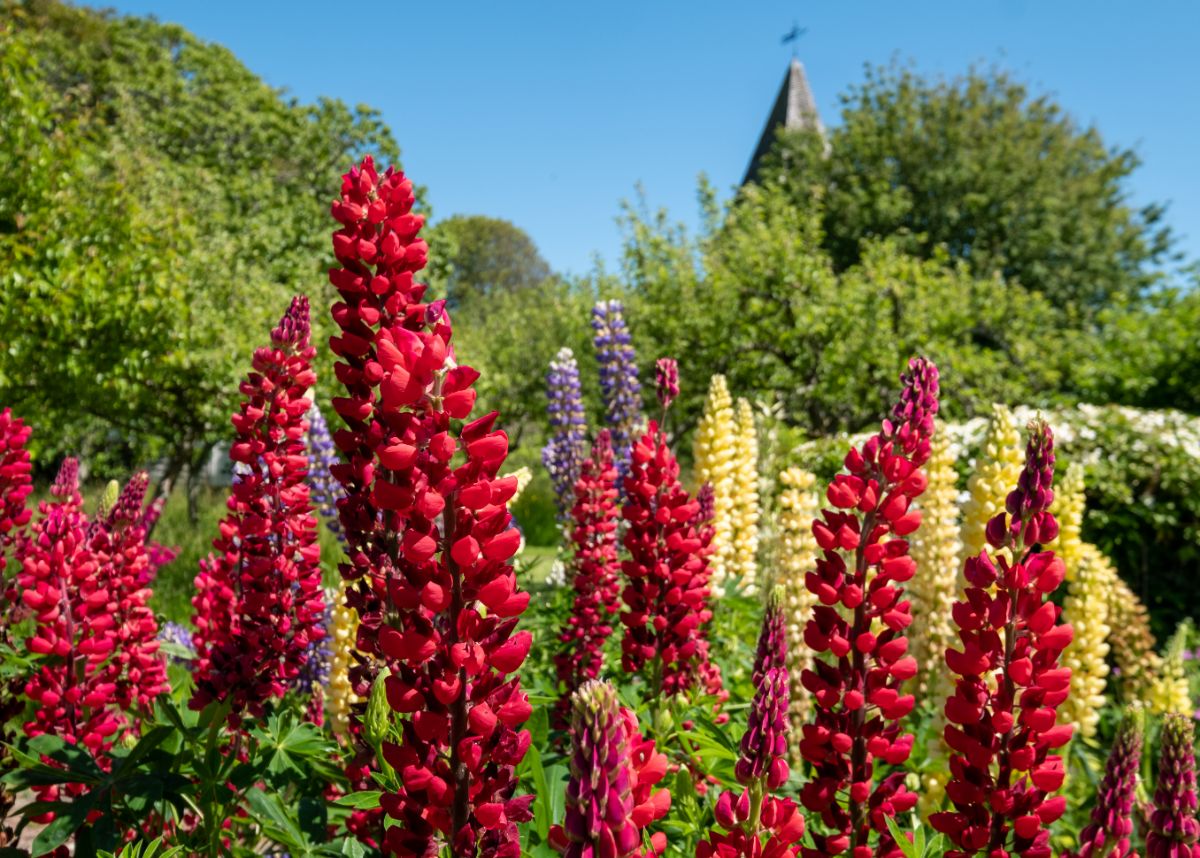
There are species of lupines that are native to Europe and the Americas. By now, annual and perennial lupine plants are grown in locations throughout the world. But in Scandinavia and the South Island of New Zealand, they are considered invasive.
Why Grow Lupines?
Here are some reasons to add these flowers with their colorful spikes to your garden:
- The tall flowers come in a variety of colors. The dense flower spikes immediately draw attention, even from across your yard.
- Lupines are deer-resistant.
- Lupines make incredible companion plants. Their nitrogen-fixing properties make the soil more suitable for neighboring flowers and vegetables.
- Bees, butterflies, and hummingbirds are all attracted to lupine. In fact, Ohio State University says, “The Karner blue butterfly depends on the wild blue lupine plant for survival, providing the butterfly with habitat, nesting grounds, and food.” So, cultivated and wild lupines might offer a big benefit to local butterflies, depending on where you live and what species are present there.
- Love cut flowers? You can really make a statement by adding lupines to your arrangements.
- Lupines need little in the way of fertilization (see below).
- These perennials are nitrogen-fixing, which means that they can help to improve the ecology in your garden. In fact, there is a whole subset of benefits here, including improvements in:
- Moisture retention in your soil
- Protection against soil erosion
- Reducing your dependency on chemical fertilizers
We will be frank—lupines can be a bit finicky, especially if you want to grow them as perennials. So, they may not be the easiest choice for beginners. But when you are rewarded with stunning flower spikes during their bloom time, it will all be worth it.
Plus, you might find some of the neighboring plants around your lupines are easier to grow with the lupines improving the soil quality!
Lupine Landscaping Ideas
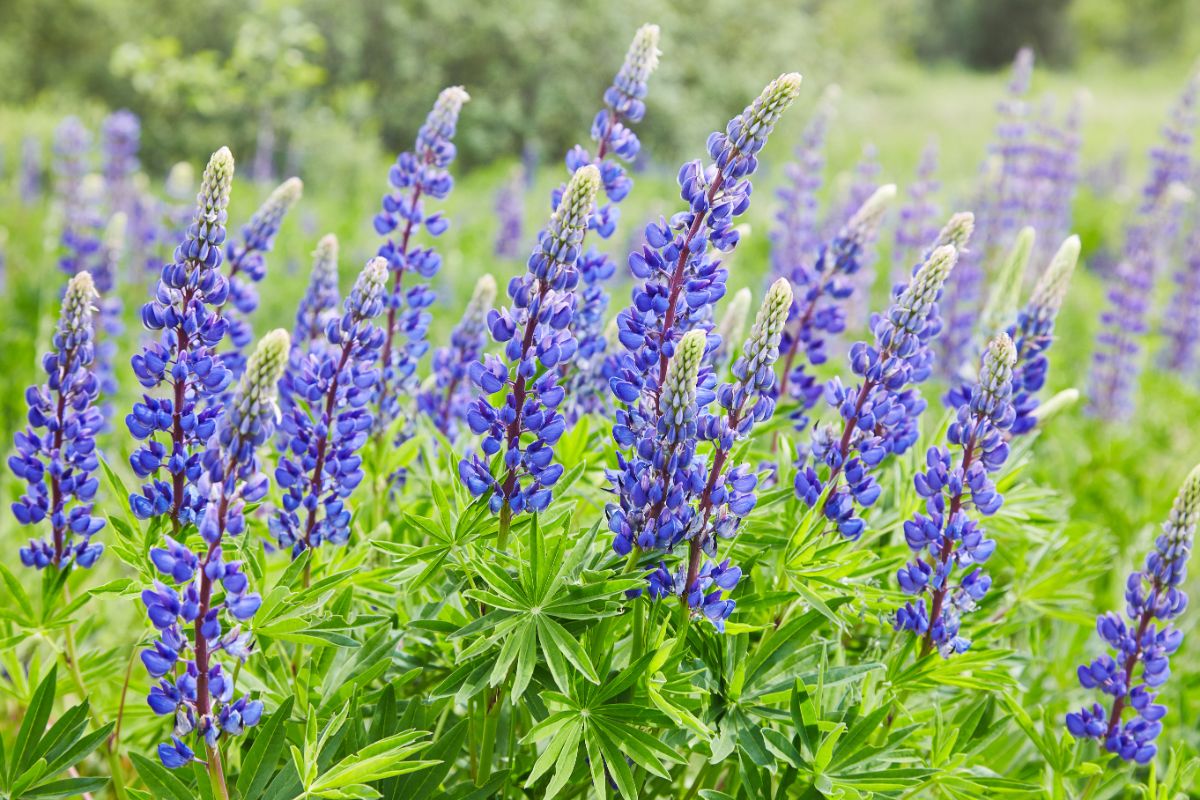
Here are a few ways you could use lupines in your landscape:
- Cottage garden. One of the best ways to use lupines in your landscaping is to capture the cottage garden look.
- Line a fence or wall. Another common way to use lupine is to create a border along a fence or a wall. In particular, this can be beneficial if the wall or fence is not aesthetically pleasing in and of itself. The lupines can bring some color and make the boundary more appealing.
- Use them as a backdrop. Consider planting garden lupines behind shorter plants to give them a colorful backdrop and fill out the space.
Recommended Lupine Varieties
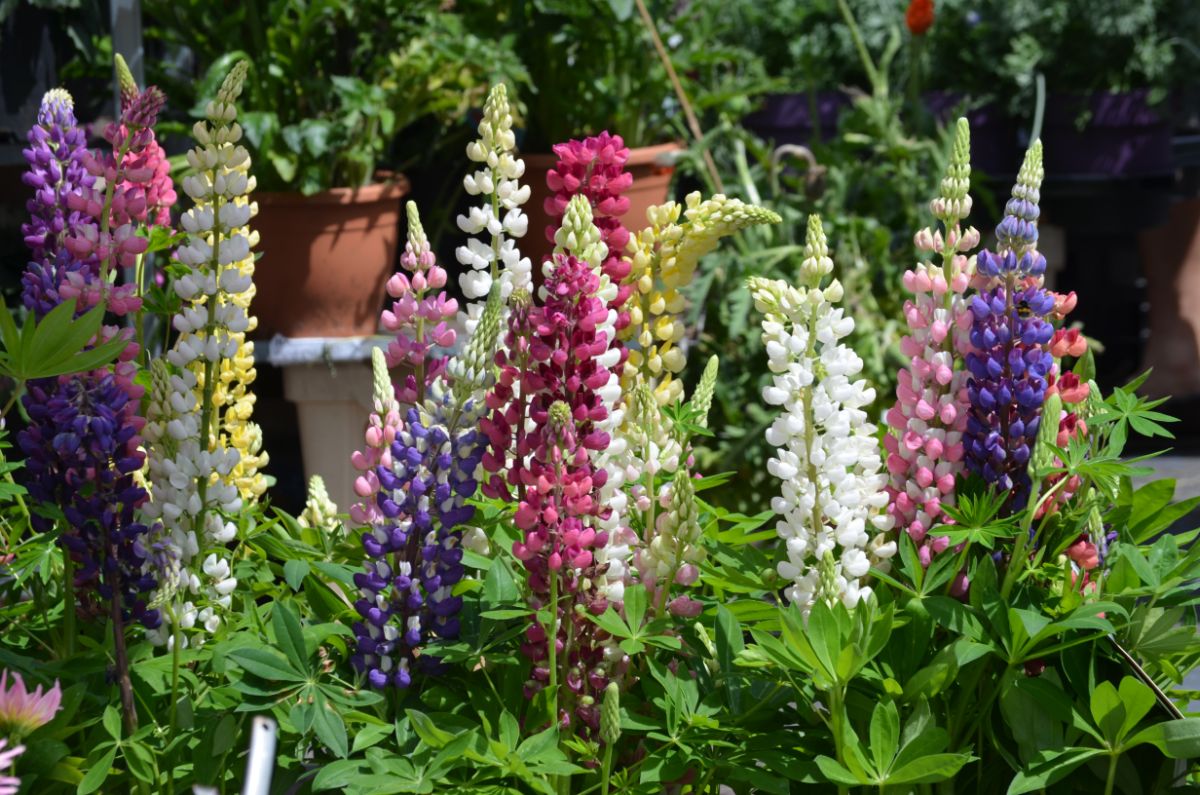
Let’s check out some beautiful lupine varieties and cultivars to add to your garden.
- Russell Lupine: These hybrid lupines produce bicolored pea flowers on spikes as long as a foot. What is really cool about Russell lupines is that they come in many different hues including red, yellow, purple, and orange. Also, these hybrids do particularly well in cool weather.
- European Yellow Lupine: As the name suggests, this is a lupine that produces yellow flowers. The bloom season runs from June into July. This is the type of lupine that many people grow for food production purposes.
- Large-Leaved Lupine: You will also see this type of lupine called “Big-Leaved Lupine” and “Many-Leaved Lupine.” It produces purple and blue flowers starting in July and running through August. Make sure you give it lots of sun.
- Wild Lupine: This type of lupine is also known as “Indian Beet,” “Blue Lupine,” and “Sundial Lupine.” The flowers it produces can be pink, purple, blue or white.
- Silver Lupine: Found along the west coast in the USA, this type of lupine also goes by the names “White-Leaf Bush Lupine” and “Evergreen Lupine.” It has a mounding growth pattern, and can reach up to five feet in height. The foliage and flowers are both beautiful, and so is the sweet fragrance. Pollinators may be particularly fond of it.
- Arctic Lupine: This lupine produces bluish-purplish flowers, and is also called “Subalpine Lupine.”
- Miniature Lupine: Most lupines are not compact plants, but one exception is the “Miniature Lupine” that can be found in parts of western North America. It seldom grows any taller than 1.3 feet.
- Yellow Bush Lupine: Another type of lupine to consider if you are looking for golden blossoms is this California native. It can grow to be particularly tall, and is appealing to a variety of pollinators.
- Riverbank Lupine: Not surprisingly, this type of lupine likes to grow close to rivers and streams.
When Do Lupines Bloom?
Lupines bloom in spring and summer.
How Long Do Lupines Bloom?
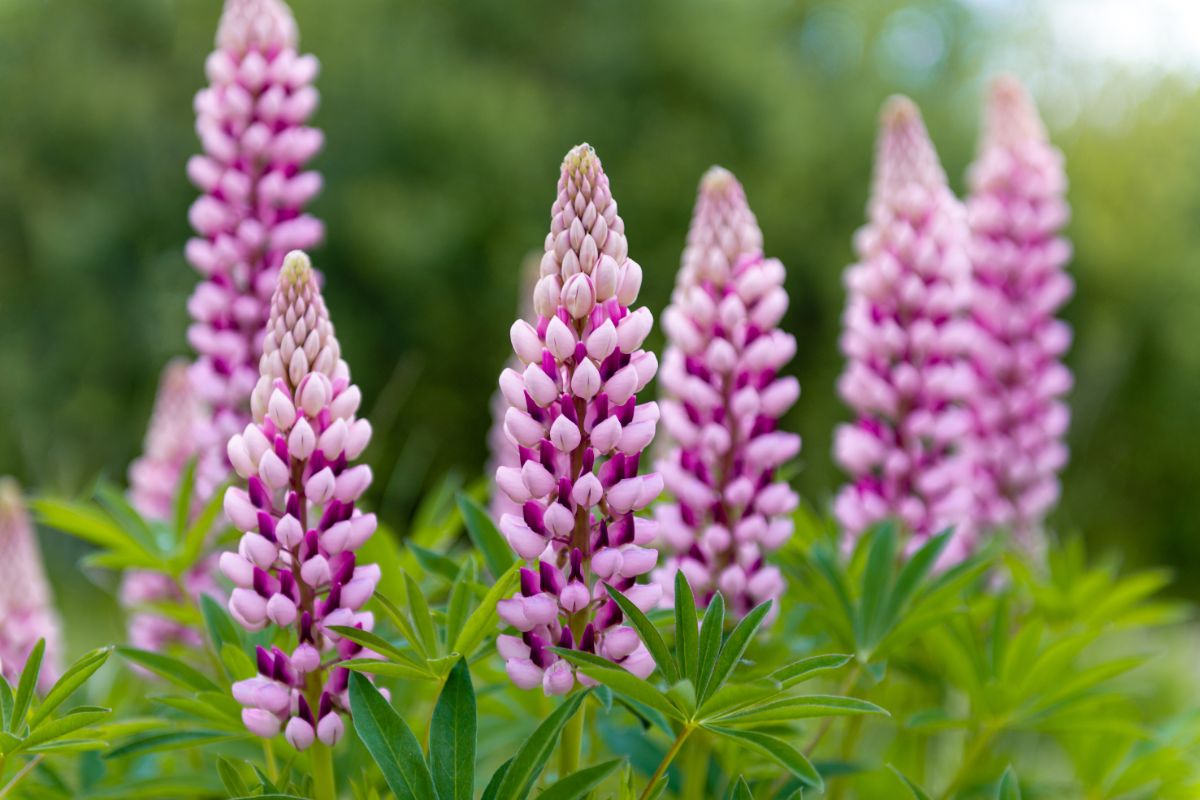
When your lupines blossom, you can look forward to enjoying them for around four weeks. If you deadhead them, you may get a second flush of blooms.
When to Plant Lupines
American Meadows says, “Lupine seeds can be planted in very early spring, but tend to do better if planted in late spring and allowed to overwinter, blooming in the following spring like foxgloves.”
If you prefer, you can plant them in late autumn or early winter.
Ideal Growing Conditions for Lupines
In order to successfully grow lupines with dramatic blooms, you will need to plant them in ideal growing conditions. Let’s talk about how much sun and water lupines need, and what type of soil is right for these perennials.
How Much Sun Do Lupines Need?
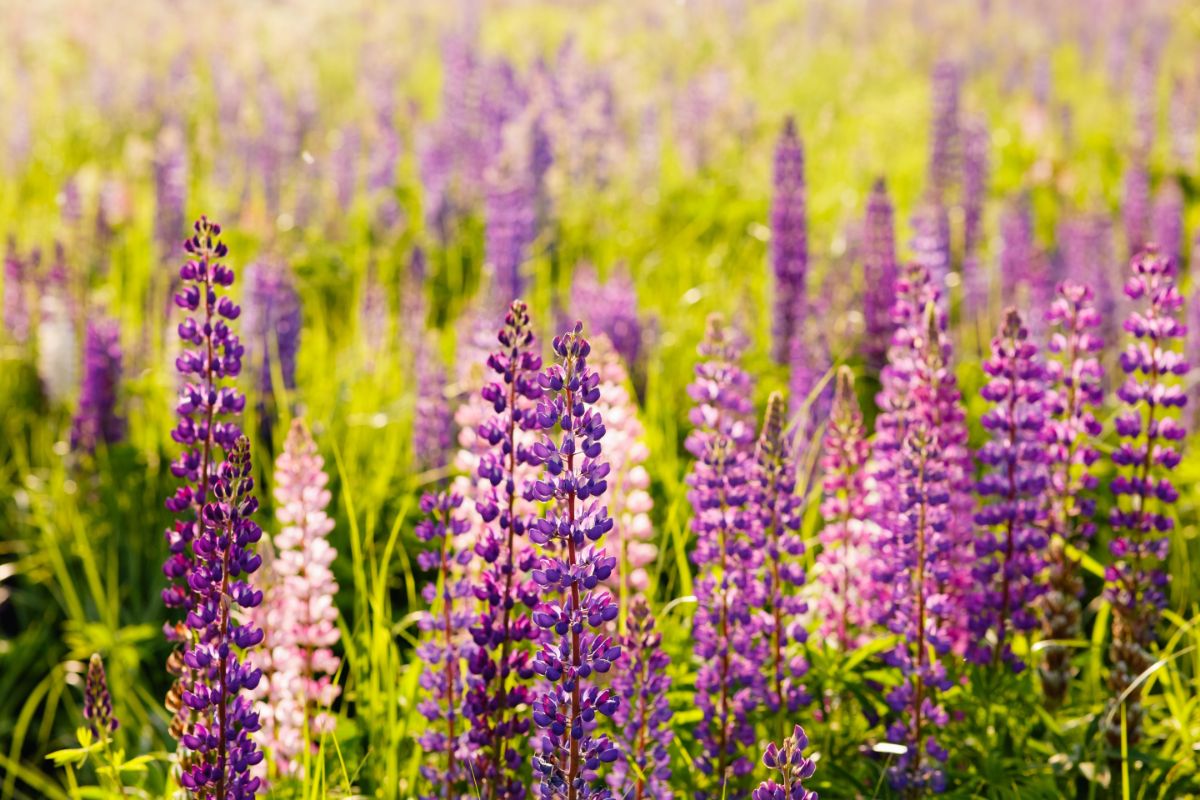
You will need to find a sunny spot for your lupine flowers. Full sunlight is best for ample flowering, but you can get away with partial shade.
What Type of Soil is Right for Lupines?
Sandy, well-drained soil is best for planting lupines. Although you want the soil moist, it should not be allowed to get soggy. Additionally, these plants produce long taproots which may have a hard time reaching down into soils that are especially heavy. So, in those situations, you should either amend the soil or go with containers so you can add a more appropriate soil.
It is best for the pH of your soil to be neutral to acidic to support the growth of lupines.
How Much Water Do Lupines Need?
One thing that makes lupine a low-maintenance plant is its low water needs. If there is a drought, you will need to water your lupine. But if you are getting normal rainfall, you probably will not need to water it at all after it is established.
How to Plant Lupines
Usually, people grow lupines from seed. But it is not uncommon to start them from nursery plants as well. So, below, we will discuss how to plant lupine starter plants in containers or your garden beds. After that, we will talk about how to start lupines from seeds and cuttings.
Container Planting

The idea of putting these tall plants in containers may seem improbable, but it can actually be done.
- Start with the right container. Hydro Builder says, “Container gardening is a great option for growing lupines. They grow quite large, so you’ll need a larger garden pot. Luckily for you, we carry fabric pots that your lupine plants will love in sizes as large as 400 gallons!”
The vendor continues, “This material is great for lupine, which needs sufficient aeration in the root zone/media. Fabric pots are super porous, so the media will dry quicker and your lupine can grow healthier. You can also consider a super-sized planter box with excellent drainage.”
- Choose the right cultivars. That means going with compact rather than taller varieties.
- Add well-draining neutral to acidic soil to your container.
- Dig holes for your lupines and plant them. As they each need 2-3 feet of space around them, you may be just putting a single lupine in each container.
- Backfill the soil and water deeply.
- Figure out a place to put your potted lupines. Remember to make sure they are getting lots of sunlight so they can produce spectacular blooms.
- Water your lupines extra as they are establishing.
How much water do your lupines need for the first few months? American Meadows suggests, “For the first few months in your garden, make sure that lupine plants are getting adequate water for good root development (they are deeply rooted), but let the soil dry out between waterings. After that, water only during periods of drought or very dry spells.”
Ground Planting
Starting with a nursery plant, here is how you can plant it in your garden bed.
- Choose a suitable spot in your garden.
- Prepare the soil. Add some organic materials to it in order to help it drain effectively and provide extra nutrition to your plant.
- Dig holes for your lupines and plant them. You should leave around 2-3 feet between each of your lupines if planting more than one.
- After your lupines are in the ground, backfill the soil and water deeply.
- As your plants are establishing, give them extra water. Once they are established, you can switch to a regular minimal watering schedule.
Starting Lupines from Seed
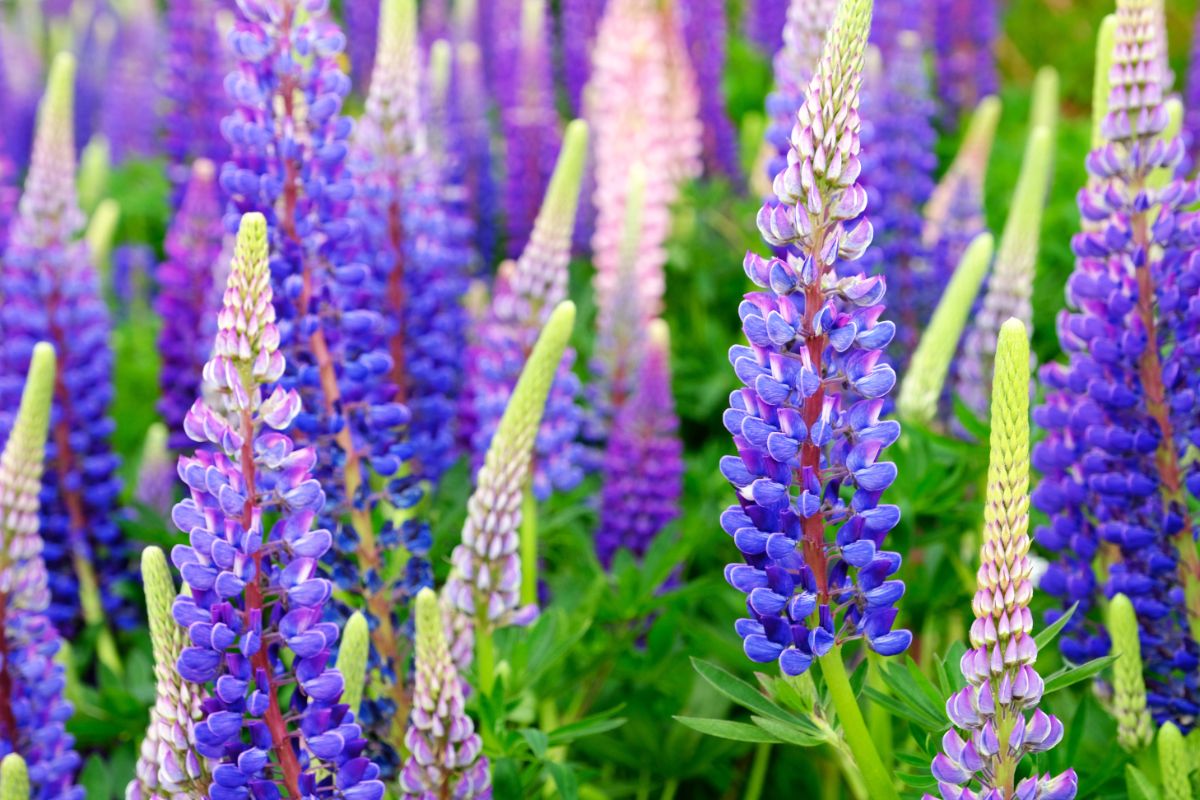
Starting Indoors
If you buy lupine seeds instead of nursery plants, or if you collect seeds from your existing plants, you can follow the steps below to start your lupines. The ideal time for this process is 4-8 weeks before you plan to plant the lupines outdoors.
- Begin by giving your seeds an overnight soak. This will help them to germinate more rapidly. You may also want to try exposing them to some cold in your refrigerator, which has a similar effect.
- Sow the lupine seeds in cell packs. Make sure that the mix is moist. Then cover them so that no light gets in.
- Wait for the seeds to germinate. Make sure you regularly check on the moisture, and mist as needed. When you see true leaves forming, you should thin out your lupines. Each container should have just a single plant.
- Now it is time to harden your seedlings. Take them outdoors for a few hours, then bring them back in, then put them back out, and so on. Each time they spend outdoors should be a little longer.
- After the plants are used to being outdoors, you can transplant them into their permanent outdoor homes.
Johnny Seeds says, “Roots of lupines are fragile and once restricted will produce inferior plants and flowers. When plants are ready to transplant, do not delay planting. Established plants do not transplant well, so it is best to plant where they will be left undisturbed.”
Starting Outdoors
In some situations, you can also consider sowing the seeds directly in your garden beds rather than starting them indoors.
- f you decide on that route, you should begin by breaking up the soil. Do this down to a depth of 1-2 feet. After you have finished loosening the soil, gently smooth it over, but do not compress it.
- Then, put the seeds down on top. Do not just scatter them. Place them with care so that they have enough space around them.
- Add around ⅛th inch of soil on top of the seeds.
- Water the area lightly. Be careful so that you do not wash the seeds out or bury them too deep.
- Wait for the seeds to germinate. Check the soil moisture regularly, and water lightly when needed. Do not let it dry out.
The time it takes for the seeds to germinate can vary quite a bit. On the short end, you could see the seedlings in a couple of weeks. But under some conditions, it could be 75 days before you see the seeds sprouting. So, try and be patient. Do not assume your seeds have failed even if it has been a couple of months.
Starting Lupines from Cuttings
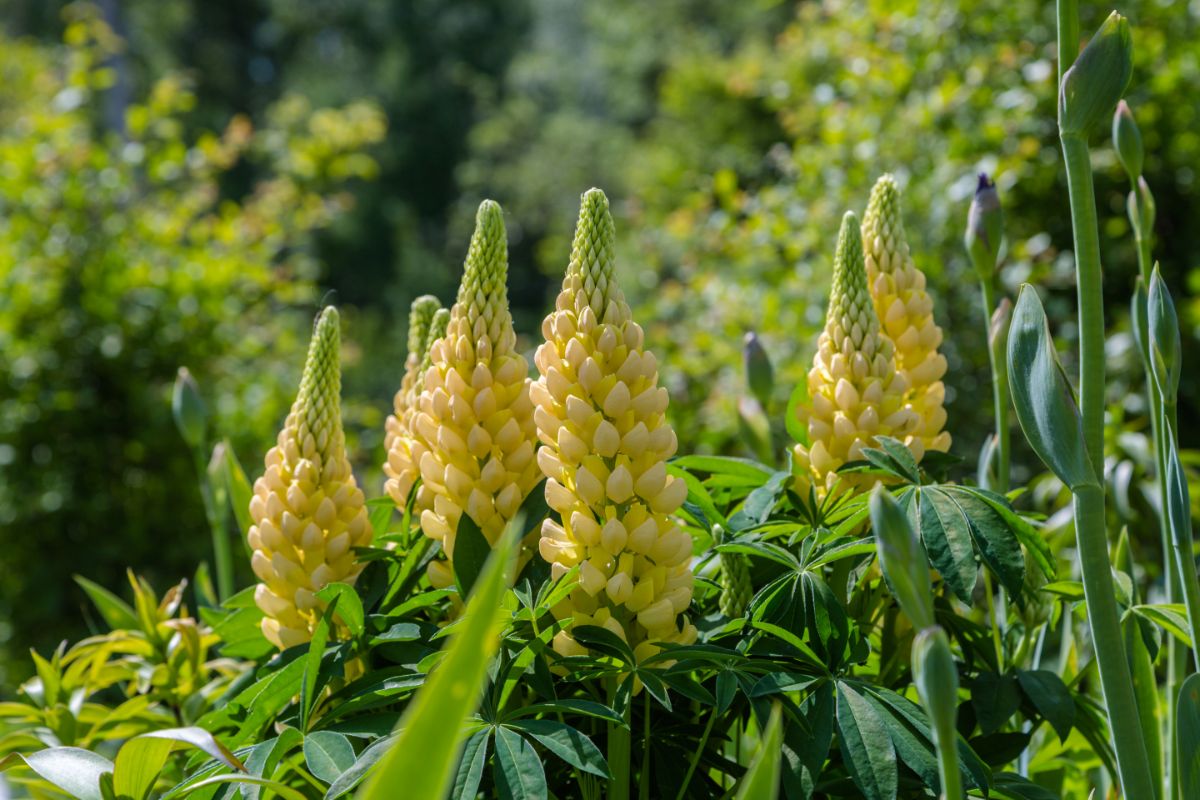
It is possible to propagate lupines from cuttings using the following steps.
- Choose a container that drains well. Add holes if necessary.
- Fill the container with masonry sand. Get the sand moist, then wait for any excess water to drain.
- Use a knife to remove a stem from an existing lupine plant. Be sure that it includes a “heel.”
- Leaving the top leaves in place, remove all the rest.
- Now, cut each of the leaves that are still on the stem in half.
- Push the cuttings down into the sand. Then pat the sand down around the stems so that they are held upright.
- Cover the container with plastic wrap, but make sure that there is room for the cuttings to grow without obstruction. You can use stakes inserted in the sand to support the plastic wrap.
- Pick a location for the container where the cuttings will receive indirect sun. The temperature should be warm.
- For most of the time, the container should stay covered. But once a day, you should remove the cover for around half an hour. This is also a good time for you to check the moisture level of the sand. If it is drying out, you should use a spray bottle to moisten it.
- In around 3-4 weeks, the cuttings should develop roots.
- At this point, you can move the cuttings to peat pots.
- Wait for your lupines to grow a little more, and then transplant them outdoors.
How to Care for Lupines
You now know how you can start growing lupines, whether from seeds, cuttings or nursery plants. But if you want them to be happy in your perennial garden, you will need to know how to take care of them. Let’s discuss fertilizing, mulching, staking and more.
How to Fertilize Lupines
American Meadows says, “Extra fertilizing is not necessary, but a top dressing of compost is appreciated, as long as it isn’t placed close to the crown of the plant.”
There are other schools of thought though. Some gardeners like to feed their lupines a phosphorus-rich fertilizer.
Tip: Avoid fertilizers with high nitrogen content. While they can boost leaf production, they may actually result in fewer flowers.
It is also easy to over-fertilize lupines. Try not to do that. Always err on the side of too little than too much.
How to Mulch Lupines
Just as lupine plants can appreciate a bit of compost, they also may like about 2-3 inches of mulch. If you live in a hot location, mulch can help the soil to retain moisture. It will also prevent weeds from encroaching on your lupines. Once again, avoid contact with the crown. That way, you can avoid rot.
How to Stake Lupines

You might worry that lupines would tend to flop over almost by default given their tall stalks of blooms. But actually, lupine stems are quite sturdy. So, in many cases, they will not need any sort of staking.
That said, if you live in a windy climate, you could have issues with some of your lupines. If that is the case, staking them can be a big help.
If you have just a few lupines, you could individually stake them. But if you have a bunch, that could be a bit tedious. So, an alternative is to use grow-through grid stakes.
How to Prune Lupines
Pruning your lupines involves both deadheading and cutting them back.
How to Deadhead Lupines
It is worth taking the time to deadhead your lupines so that they produce a second flush of blooms. Be sure to do this quickly following wilting; do not give the seeds time to start. The side shoots should produce new blossoms, albeit likely not as heavily as the original flush of blooms.
When to Cut Back Lupines
The right time to cut back your lupines is after the bloom season has passed.
Alas, cutting back lupines is tricky, because these plants can die if you take off too much.
For that reason, it is advised that you take a conservative approach. Remove the flower spikes, and then think about leaving the rest of the plant alone.
In other words, rather than cutting all the way down to the ground, it is more like you should be deadheading twice.
We have seen some sources recommend cutting down to the ground, but based on our research, this does not seem like a reliable approach.
How to Divide and Transplant Lupines
If you are hoping to divide and transplant lupines, you may be disappointed. American Meadows says, “Lupines have deep roots and do not transplant well as they get bigger. Moreover, they start growing very early in the spring when digging and transplanting might not be advisable. … Lupine does not need to be divided and is actually difficult to divide due to its deep tap root.”
Are Lupines Vulnerable to Diseases or Pests?
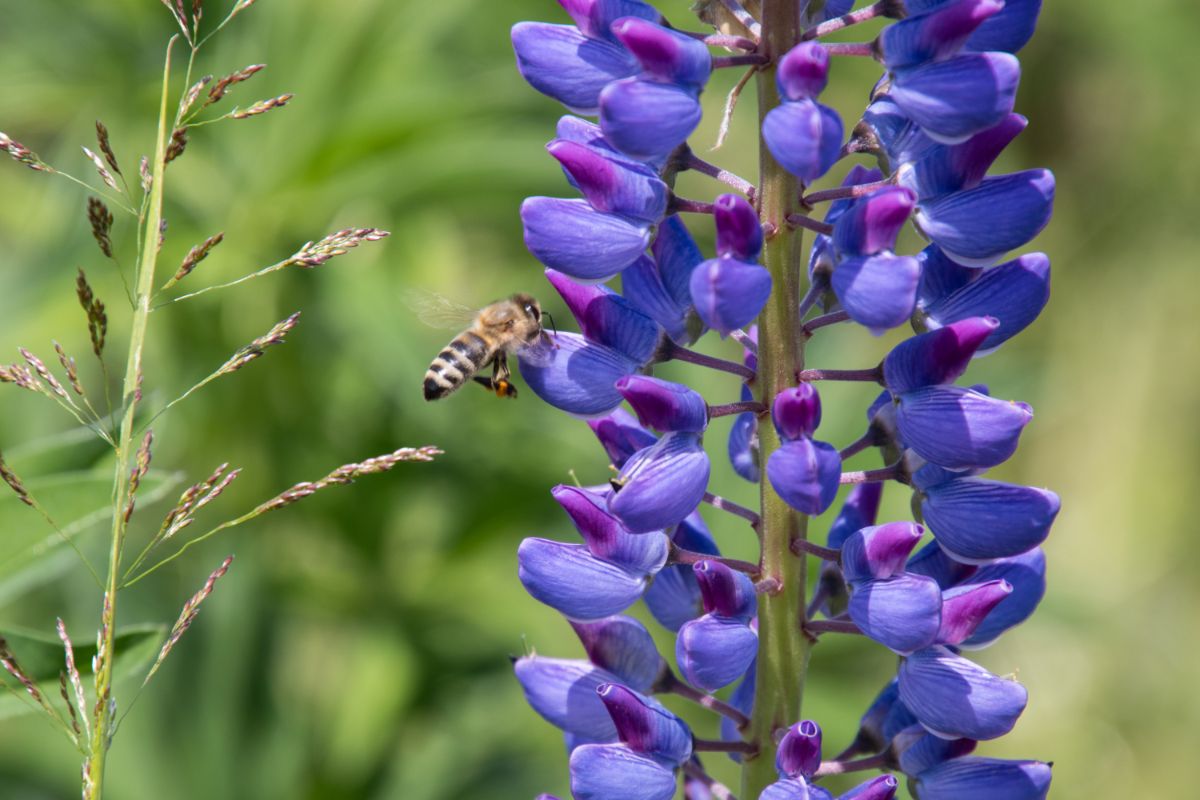
The diseases that seem most likely to affect lupines include powdery mildew, leap spots and Anthracnose.
How do you know if your lupines have powdery mildew? Pacific Northwest Pest Management Handbooks says, “White powdery spots that may quickly cover the entire leaf. Lesions may occur on widely scattered plants early in the season but can be almost uniform on heavily infected plants by late summer. Small black dots (cleistothecia) may be seen later in the white areas.”
Leaf spots can be caused by a variety of infections. Some of these include Ovularia, Thedgonia, and Anthracnose.
How can you protect your lupines from disease? The best thing to do is just to take care while planting that you are providing enough space between each of your lupines. While you are at it, do not plant them too close to other plants in your garden either.
You might need to be extra mindful of this if you are trying for a cottage garden, which often involves creating a very dense, abundant appearance. Do not be tempted into compromising the airflow around your lupines in your attempt to capture this look.
Along with diseases, there are some pests you should watch out for on your lupines. These include aphids, thrips, slugs, and snails.
Aphid infestations can become particularly problematic on lupines. As West Coast Seeds explains, “Lupin Aphids (Macrosiphum albifrons) are real specialists. As they suck fluids from the lupins’ tissues, they absorb the alkaloids, which makes them unpalatable (possibly toxic) to the insects that would normally act as control species. There are four species of parasitoid wasps that do prey on these aphids, but not in sufficient numbers to control this kind of population. Ladybird beetles, for instance, do not eat Lupin Aphids.”
What can you do if your lupines are plagued by aphid attacks? You can find a few helpful suggestions over at Ask Extension. If possible, you should avoid harming beneficial insects such as ladybugs.
Intriguingly enough, there is an insect called an “insidious flower bug” (yes, for real) that you might discover on your lupines from time to time. But these are not pests! Actually, they are thrip hunters. So, do not remove them. They are here to help.
While we are on the topic of pests, you might be wondering if mammals are a threat to your lupine plants. In most cases, the answer is “no.” If deer or other mammals are tempted by your lupines, it will probably be while they are in their early growth stages. As they mature, they become repellent to deer.
Recommended Companion Plants for Lupines

When you plant your lupines, you will need to put some thought into what to plant next to them. Here are a few companion planting possibilities to consider.
- Vegetables. If you have a vegetable garden, it may be useful to plant lupines next to your veggies. Why? The nitrogen-fixing benefits of lupines will improve soil quality for your other plants. Since you will not need to depend as much on chemical fertilizers, you can grow your veggies in a more organic way.
- Alliums. These ornamental flowers blossom at the same time as lupines. With their spherical shapes, they make a pleasing juxtaposition against the flower spikes of the lupines, creating an almost geometric effect.
- Perennial cornflower. This is a great choice for a blue flower in late spring to complement your lupines. It also goes by the name “mountain bluet.”
- Phlox. Depending on the cultivar you get, these showy flowers can begin blossoming as early as mid-summer. Ranging up to several feet in height and available in a wide variety of colors, they can be stunning planted along with lupines.
Frequently Asked Questions About Growing Lupines
Aphids, thrips, slugs, and snails are most likely to be eating your lupines.
Perennial lupines are most common, but there are also annual lupines. So, be mindful of what you are purchasing so that you get lupines that come back every year.
Where to Buy Lupines
If you are ready to plant colorful lupine flowers to achieve the magical look of a cottage garden, you can click this link to shop for lupines online.

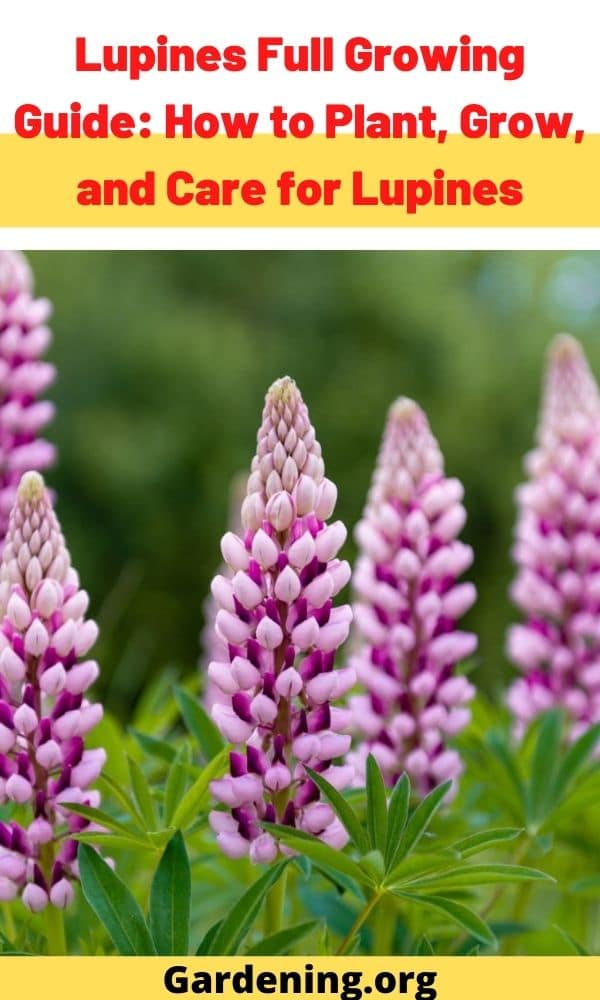







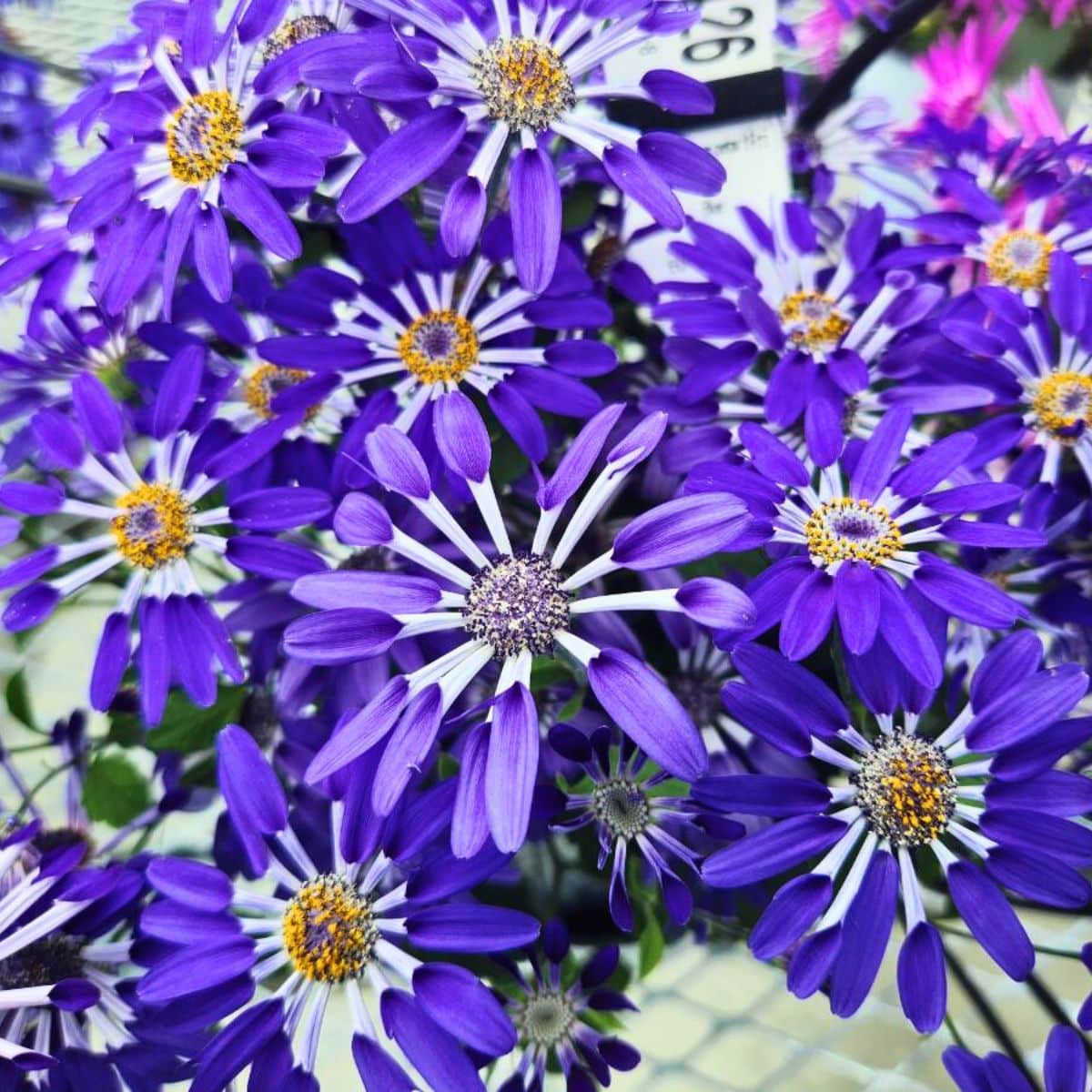
Jeanne Sovienski
Love the lupines Have a good number of them in the garden. very informative article. I learned much.
jeanne sovienski
Is there some way I can receive further articles on gardening
Mary
Purchased a Lupine plant from a garden store in spring.
Still has no blooms. Do they not bloom the first year. Live in Illinois